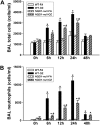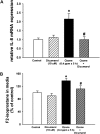NAD(P)H quinone oxidoreductase 1 is essential for ozone-induced oxidative stress in mice and humans
- PMID: 19059883
- PMCID: PMC2701957
- DOI: 10.1165/rcmb.2008-0381OC
NAD(P)H quinone oxidoreductase 1 is essential for ozone-induced oxidative stress in mice and humans
Erratum in
-
Erratum: NAD(P)H Quinone Oxidoreductase 1 Is Essential for Ozone-Induced Oxidative Stress in Mice and Humans.Am J Respir Cell Mol Biol. 2016 Dec;55(6):909. doi: 10.1165/rcmb.556erratum. Am J Respir Cell Mol Biol. 2016. PMID: 27906558 Free PMC article. No abstract available.
Abstract
One host susceptibility factor for ozone identified in epidemiologic studies is NAD(P)H quinone oxidoreductase 1 (NQO1). We hypothesized that after ozone exposure, NQO1 is required to increase 8-isoprostane (also known as F(2)-isoprostane) production, a recognized marker of ozone-induced oxidative stress, and to enhance airway inflammation and hyperresponsiveness. In this report, we demonstrate that in contrast to wild-type mice, NQO1-null mice are resistant to ozone and have blunted responses, including decreased production of F(2)-isoprostane and keratinocyte chemokine, decreased airway inflammation, and diminished airway hyperresponsiveness. Importantly, these results in mice correlate with in vitro findings in humans. In primary human airway epithelial cells, inhibition of NQO1 by dicumarol blocks ozone-induced F(2)-isoprostane production and IL-8 gene expression. Together, these results demonstrate that NQO1 modulates cellular redox status and influences the biologic and physiologic effects of ozone.
Figures






Comment in
-
Findings of Research Misconduct.Fed Regist. 2019 Nov 7;84(216):60097-60098. Fed Regist. 2019. PMID: 37547121 Free PMC article. No abstract available.
Similar articles
-
NADPH:quinone oxidoreductase 1 regulates host susceptibility to ozone via isoprostane generation.J Biol Chem. 2013 Feb 15;288(7):4681-91. doi: 10.1074/jbc.M112.438440. Epub 2012 Dec 28. J Biol Chem. 2013. PMID: 23275341 Free PMC article.
-
Nitric oxide synthase inhibitors attenuate ozone-induced airway inflammation in guinea pigs. Possible role of interleukin-8.Am J Respir Crit Care Med. 2000 Jan;161(1):249-56. doi: 10.1164/ajrccm.161.1.9804096. Am J Respir Crit Care Med. 2000. PMID: 10619828
-
NAD(P)H quinone oxidoreductase 1 regulates neutrophil elastase-induced mucous cell metaplasia.Am J Physiol Lung Cell Mol Physiol. 2012 Aug 1;303(3):L181-8. doi: 10.1152/ajplung.00084.2012. Epub 2012 Jun 1. Am J Physiol Lung Cell Mol Physiol. 2012. PMID: 22659878 Free PMC article.
-
Effects of ozone repeated short exposures on the airway/lung inflammation, airway hyperresponsiveness and mucus production in a mouse model of ovalbumin-induced asthma.Biomed Pharmacother. 2018 May;101:293-303. doi: 10.1016/j.biopha.2018.02.079. Epub 2018 Feb 27. Biomed Pharmacother. 2018. PMID: 29499403
-
NAD(P)H quinone oxidoreductase (NQO1): an enzyme which needs just enough mobility, in just the right places.Biosci Rep. 2019 Jan 3;39(1):BSR20180459. doi: 10.1042/BSR20180459. Print 2019 Jan 31. Biosci Rep. 2019. PMID: 30518535 Free PMC article. Review.
Cited by
-
PGI synthase overexpression protects against bleomycin-induced mortality and is associated with increased Nqo 1 expression.Am J Physiol Lung Cell Mol Physiol. 2011 Oct;301(4):L615-22. doi: 10.1152/ajplung.00224.2010. Epub 2011 Jul 15. Am J Physiol Lung Cell Mol Physiol. 2011. PMID: 21764988 Free PMC article.
-
Gastrin-releasing peptide blockade as a broad-spectrum anti-inflammatory therapy for asthma.Proc Natl Acad Sci U S A. 2011 Feb 1;108(5):2100-5. doi: 10.1073/pnas.1014792108. Epub 2011 Jan 20. Proc Natl Acad Sci U S A. 2011. Retraction in: Proc Natl Acad Sci U S A. 2015 Apr 7;112(14):E1813. doi: 10.1073/pnas.1504672112. PMID: 21252304 Free PMC article. Retracted.
-
Update in environmental and occupational medicine 2009.Am J Respir Crit Care Med. 2010 Jun 1;181(11):1174-80. doi: 10.1164/rccm.201002-0183UP. Am J Respir Crit Care Med. 2010. PMID: 20516491 Free PMC article. Review. No abstract available.
-
Regulation of Wnt4 in chronic obstructive pulmonary disease.FASEB J. 2013 Jun;27(6):2367-81. doi: 10.1096/fj.12-217083. Epub 2013 Mar 5. FASEB J. 2013. PMID: 23463699 Free PMC article.
-
Genetic evidence for NAD(P)H:quinone oxidoreductase 1-catalyzed quinone reduction on passage through the mouse pulmonary circulation.Am J Physiol Lung Cell Mol Physiol. 2011 May;300(5):L773-80. doi: 10.1152/ajplung.00394.2010. Epub 2011 Feb 4. Am J Physiol Lung Cell Mol Physiol. 2011. PMID: 21296895 Free PMC article.
References
-
- American Thoracic Society. Health effects of outdoor air pollution. Part 2. Committee of the Environmental and Occupational Health Assembly of the American Thoracic Society. Am J Respir Crit Care Med 1996;153:477–498. - PubMed
-
- Peden DB. The epidemiology and genetics of asthma risk associated with air pollution. J Allergy Clin Immunol 2005;115:213–219. (quiz 220). - PubMed
-
- Foster W. Effects of oxidants. In: Swift D, Foster W, editors. Air pollutants and the respiratory tract. New York: Marcel Dekker; 1999. pp. 147–179.
-
- Trasande L, Thurston GD. The role of air pollution in asthma and other pediatric morbidities. J Allergy Clin Immunol 2005;115:689–699. - PubMed
-
- Gent JF, Triche EW, Holford TR, Belanger K, Bracken MB, Beckett WS, Leaderer BP. Association of low-level ozone and fine particles with respiratory symptoms in children with asthma. JAMA 2003;290:1859–1867. - PubMed
Publication types
MeSH terms
Substances
Grants and funding
LinkOut - more resources
Full Text Sources
Medical
Molecular Biology Databases
Miscellaneous

